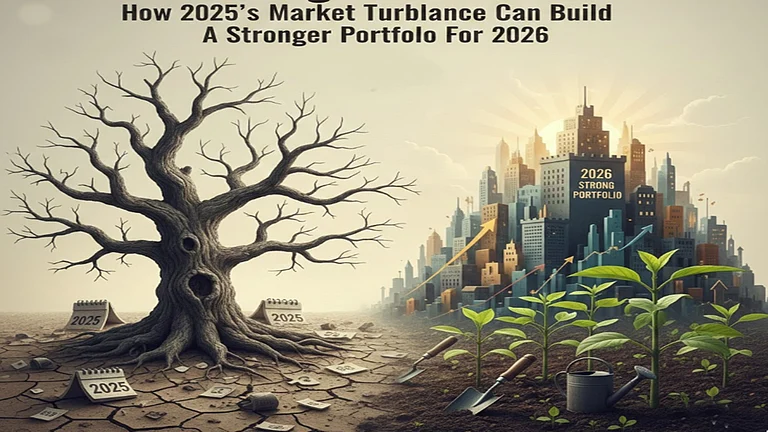For the Indian consumer (or investor) ‘Gold’ has always been a symbol of wealth and security. Over centuries, it has been safely locked or popularly adorned as a ‘safe-haven’ asset - not only by regular people but also seasoned investors.
But as we step into 2025, Indian consumers and investors are faced with one critical question; can gold maintain its allure as a strategic asset in their portfolio? The answer lies in the gold prices data from not long ago.
On Thursday, gold prices in India recorded a new high and rose Rs 170 at Rs 82,900 per 10 grams in Delhi. In about one year, gold surged by Rs 20,180 to Rs 82,900 from Rs 62,720 on February 23, 2024.
The latest report by the World Gold Council highlights its long-term resilience indicating that there are potential risks and challenges of including gold as a strategic asset in your portfolio. Let’s understand what Indian investors should consider before taking the leap this year.
Why Gold has a timeless appeal?
It is viewed as a financial safe haven that has historically performed well during economic downturns, coupled with its dual role as both an investment and a consumer good.
A look at the WGC report notes shows that gold has delivered annualised returns of 8 per cent since the end of the gold standard in 1971, outperforming many asset classes such as bonds and commodities. For Indian investors, such enduring returns would also align with gold’s long-held cultural significance in households.
However, one thing that truly puts gold as an ultimate addition to your portfolio is its ability to hedge against ‘inflation’. When prices spiral, gold has historically surged, preserving wealth when other assets have faltered.
Even during periods of deflation, when consumption and investments take a downturn, gold’s demand often sees a spike due to its status as a counter-cycle asset.
Now let’s access various risks and challenges of including gold in your portfolio;
Any investment you make will always have its advantages but not without a flipside.
Gold has a dual nature as both an investment and a consumer good. However, it's equally important to know the challenges that can arise out of investing in it. Here are some key factors to note;
1) No Regular Income: Unlike stocks, bonds, or real estate, gold investments do not give you any regular cash flow such as dividends, interests, or rent. A gold investors’ catch lay in its price appreciation, which has been historically known to be robust, but is definitely not guaranteed.
The reason for this is simple, WGC notes, “Gold has no credit risk. There is no promise to repay. Nor does it bear any counter-party risks.”
2) Price Volatility: While gold is less volatile than some equities or commodities, it is not immune to sharp price movements. This means that investors depend on price appreciation to benefit from gold. For instance, gold posted significant gains in 2010 but did falter in 2013. Investors must prepare themselves for fluctuations in the market.
“While gold is a less volatile asset than some equity indices, other commodities or alternatives, in some years the metal has posted close to 30 per cent gains (2010) and in other years it has posted close to 30 per cent losses (2013),” the analysis notes.
However, citing the global financial crisis (GFC) as a case in point, WGC also notes that;
“Equities and other risk assets tumbled in value, as did hedge funds, real estate, and most commodities, which were long deemed portfolio diversifiers. Gold, by contrast, held its own and increased in price, rising 21 per cent in US dollars from December 2007 to February 2009. And in the most recent sharp equity market pullbacks of 2020 and 2022, gold’s performance remained positive.”
3) Global Economic Outlook: Gold fares highly depending on the global economic dynamics where its performance is intricately tied to global macroeconomic conditions. Many factors including central bank policies, the performance of the US Dollar, and geopolitical tensions significantly impact its price movement.
4) Liquidity Risks for Retail Investors: Even though gold is traded globally, for a retail investor or consumer physical gold is not as easy to liquidate, especially for the people of rural India.
5) Other Alternative Investments: The market today is abreast with various investment options, ranging from equities, and mutual funds to digital assets. Amid such competitions, which promise compounded returns, gold faces competition for investor’s attention.
The younger and tech-savvy group (such as millennials and Gen Z ) may prefer the allure of higher growth over going for the traditional safe haven asset.
Despite these challenges, gold holds its momentum. The WGC analysis notes how adding a modest allocation of gold (around 5-10 per cent) can improve the portfolio of an investor with risk-adjusted returns. “Gold’s low correlation with equities and bonds means that it can perform well during financial crises or stock market sell-offs.”
It further adds that with a growing emphasis on environmental, social, and governance (ESG) standards, this commodity can offer a unique advantage. “Gold has a potential role to play in reducing investor exposure to climate-related risk,” the report states.
So what should an investor do?
The answer lies in maintaining a ‘balance’. While for Indian households, the metal continues to hold an undisputed role as a hedge against inflation, for millennials and Gen Z investors, digital gold or gold exchange-traded funds (ETFs) may offer a more convenient and flexible way to invest.
As a smart investor, before committing you should realise the purpose of your investment. Are you buying gold for its cultural value, as a safety net, or as a part of your portfolio diversification? Finding answers to these questions will guide you toward a strategic investment.
Also, follow Outlook Money's Budget 2025 expectations stories here.

















